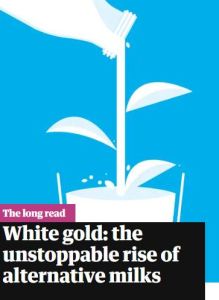Join getAbstract to access the summary!

Join getAbstract to access the summary!
Oliver Franklin-Wallis
White Gold
The Unstoppable Rise of Alternative Milks
The Guardian, 2019
What's inside?
Got milk?
Recommendation
You might not realize it, but changing attitudes toward the environment, health and animal welfare have turned the alternative-milks market into a multibillion-dollar industry that might be beginning to challenge the dairy industry. Young people no longer see milk as a fount of health, preferring alternatives like nut or plant milks. Milk, they might say, is food for baby cows, not for humans. This informative article from Oliver Franklin-Wallis is a good read for anyone interested in how changing social attitudes can be as disruptive as technological change – or for those baffled by the recent transformation of the dairy aisle.
Summary
About the Author
Oliver Franklin-Wallis is a freelance writer whose work has appeared in The Guardian, British GQ, Wired and The Sunday Times, among others. He’s also a contributing editor at Wired UK.









Comment on this summary